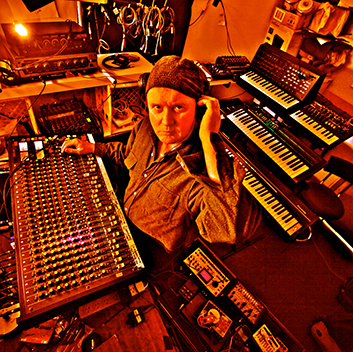When Michael Mildren commenced work on Process 1: Studies in Kraft, out now from Clan Analogue, an epic journey of exploration ensued. A search for the right gear to produce Kraftwerk’s classic tracks spanned continents. The focused critical listening to minutely analyse every aspect of Kraftwerk’s compositions and sound design took months. Practice with synth programming, effects tweaking and performance techniques was another huge undertaking.
Here Michael recounts some of the processes he explored:
“I only had basic analogue gear when I started… the 1973 Roland SH1000, Elgam electric piano/harpsichord, Mattell Synsonics drum machine and a few other bits and bobs. I immediately started to explore eBay and the local Music Swap Shop for anything I could afford that might generate good analogue sounds.
“The lead melody in ‘Neon Lights’ sounded like it might have been an Arp Odyssey. I found the flute sound on an early eighties sound module (EM101) whcih gave a reasonable estimation of it. I used the same sound for the melody in ‘Europe Endless’.
“For all vocoder parts I used my old Roland SVC350 vocoder with the organ or string sound from an old Casio keyboard. I bought an old EHX Small Stone phaser pedal online from Lismore to treat the EM101 organ sound for ‘Autobahn’.
“I found a French Texas Instruments Language Tutor (1978 voice synthesiser) on eBay from Palm Beach, Queensland, and a Spanish one from Canada, to use on ‘Pocket Calculator’ and ‘Computer World’. I found an original stylophone on eBay from an RSPCA op shop in a quaint English village.
“Laying out each original Kraftwerk song on a track in Ableton Live then setting the file to the nearest BPM, I would reference the original and slowly build up my version part by part. This was mostly live real-time playing with occasional sequenced parts on a newly bought Arturia Microbrute.
“I steadily added to my analogue gear setup over the year that I was working on the recordings. I traded some gear for a good drum machine, the Electron Machinedrum Mk1, which made drum programming possible. With some songs I would make a simple pattern and then play snare or other parts live on separate tracks.
“I also played live snare and hi hats parts on a Mattel Synsonics, particularly the ‘Computer World’ flams. Also on ‘Computer World’ I discovered rhythmic lines which I’d thought were 16ths but which were 1/8th notes doubled through a delay, so I learned how to set the delay rate of my Roland DC30 to replicate this effect.
“When I recorded ‘Man Machine’, I still didn’t have a polysynth that had filter sweep, so I put the EM 101 through a Korg Monotron which I had bought years earlier and which has an MS20-like filter, playing and tweaking the part live.”
Process 1: Studies In Kraft from Michael Mildren is available now from Clan Analogue. Look out for the next release in Michael Mildren’s release series: Process 2: Post-Kraft.


